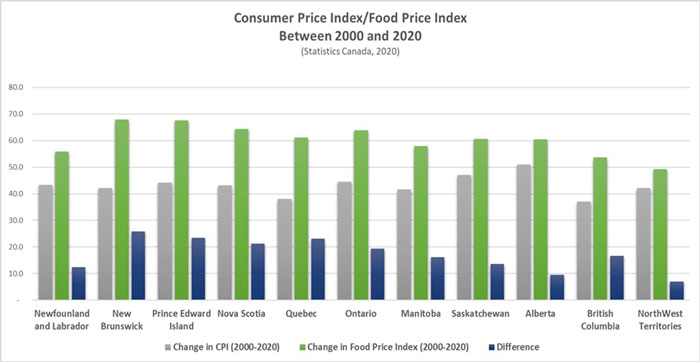Noticed your grocery bill seems to be getting higher? Here’s why
- Like
- Digg
- Del
- Tumblr
- VKontakte
- Buffer
- Love This
- Odnoklassniki
- Meneame
- Blogger
- Amazon
- Yahoo Mail
- Gmail
- AOL
- Newsvine
- HackerNews
- Evernote
- MySpace
- Mail.ru
- Viadeo
- Line
- Comments
- Yummly
- SMS
- Viber
- Telegram
- Subscribe
- Skype
- Facebook Messenger
- Kakao
- LiveJournal
- Yammer
- Edgar
- Fintel
- Mix
- Instapaper
- Copy Link
Posted: 23 September 2020 | Dr. Sylvain Charlebois | No comments yet
Every month, Statistics Canada reminds us that life is getting more expensive. But for food, the situation has been unique over the last few decades.


Based on numbers released recently, the price of a typical grocery basket has increased by about 240 percent since 2000. Some will think that such a percentage is expected, given the effects of inflation…perhaps, but the overall cost for other products and services in the economy did not increase as much as food did – far from it.
In fact, it is when we compare the consumer price index with the food price index over the last 20 years that we see a rather marked divide. Except for Iqaluit, Canada, all provinces and territories have seen their consumer price indices outstripped by the food price index. In most cases the food price index has gained at least 10 points more in 20 years.
The differences are larger in Eastern Canada. In Quebec, the difference between the two is 23.1 points and in Nova Scotia, 21.3 points. The place where the food price index exceeded the general price index the most is in New Brunswick, with 25.8 points. In other words, over the past 20 years Canadian households, especially in Eastern Canada, have had to spend more of their budgets on food. It is particularly over the last decade that the gap between the two indices has widened. For the Eastern provinces, the reasons vary between the lack of regionally-based food processing and the higher logistical costs of serving some remote markets.


Some may claim that a sustained rise in food prices may be harmful to the poorest citizens. Well, yes and no.
North America has been the realm of discounted food for quite some time. We are just emerging from an era in which we have been bent on buying the cheapest food products. For a generation, food industrialisation has led us to consume both good and questionable food and we accepted our fate without thinking much about it.
But things are different now. As affordability remains a priority for the agri-food sector, quality, the provenance of food, and the ecological footprint that our choices represent bring their share of complexity and additional costs. The demanding consumers that we have now become have plenty of choice, all year round. Greater innovation brings improved quality, but there is certainly a price to pay for that. As a result, the industry has been catching up with our expectations by managing higher costs and passing some of the increases onto us. It will only get worse with COVID-19. Simple economics.


Peanut butter and sugar have been relatively cheap in Canada for 20 years.
However, the fact remains that some people are struggling to make ends meet. Poverty is invisible but it exists; it surrounds us and will become more of a challenge over the next few months. It is high time we evaluate the possibility of a guaranteed minimum income, for greater financial equity for all.
Despite higher food inflation, there is still some good news for bargain hunters. For several years now, we have focused on discussing the more expensive food products. It is just human nature. But did you know that there are a few products priced almost the same as they were 20 years ago? According to Statistics Canada, flour has increased by 38 percent since 2000, which isn’t much. Even better, peanut butter is about five percent more expensive than in 2000. Of course, prices will vary depending on the region, the type of store, and the time of year. But peanut butter has been relatively cheap for 20 years. But apparently, sugar is dirt cheap in Canada.
According to Statistics Canada, white sugar is almost the same price as it was in 2000, at $2.40 per 2 kilograms. Although there are only a few sugar producers in Canada that control the market – Redpath and Lantic and Rogers in the West – the price of sugar has barely changed in the last two decades.
The sugar industry operates mostly behind the scenes, and everything is negotiated privately. Canadian prices are based on world sugar prices, which are significantly lower than prices supported by tariffs in the United States and Europe. Canada’s low import tariffs also mean that global competition for refined sugar keeps prices low here compared to the United States. In fact, sugar prices in Canada are on average about 35 percent lower than US sugar prices.
So, there you have it. Food prices are going up, but at least sugar and peanut butter remain a bargain.








